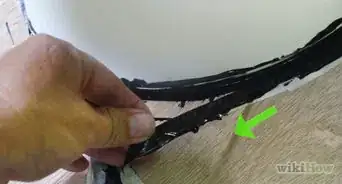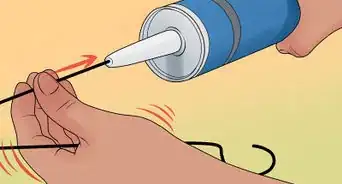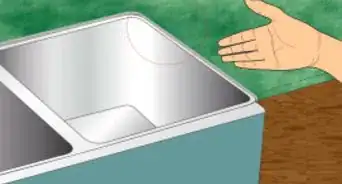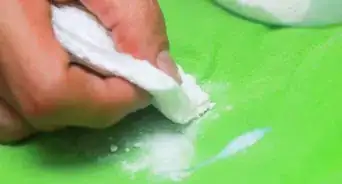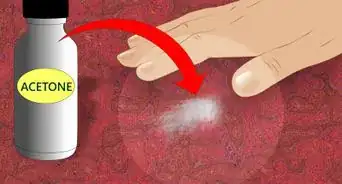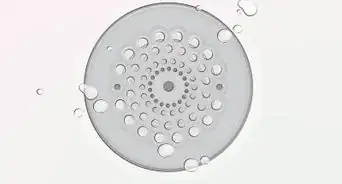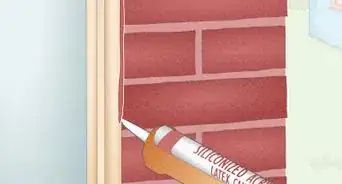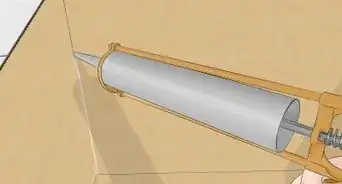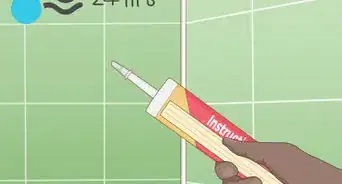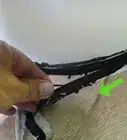This article was co-authored by Eric Shipe and by wikiHow staff writer, Luke Smith, MFA. Eric Shipe is a Kitchen and Bath Designer and the Owner of Bath + Kitchen based in Washington DC. Eric and his team specialize in cabinetry, design, and remodels. They serve homeowners, interior designers, architects, and contractors with a refined process, creative ideas, 4K photo-realistic renderings, and 360 Panoramic views. Bath + Kitchen was featured in Best of Houzz 2017-2020. Eric holds a BA in Economics and Business Administration from Ursinus College.
There are 8 references cited in this article, which can be found at the bottom of the page.
This article has been viewed 243,775 times.
It’s time for that bathroom remodel, and you’re eyeing that old silicone caulking dubiously. Or maybe it’s just time to refresh the seals around the bathtub by removing and reapplying the caulk. In any case, we’re here to help. We’ll walk you through how to easily remove silicone sealant from 4 different surfaces, including tile, glass, metal, and wood, to have your home’s nooks and crannies looking like new in no time.
Things You Should Know
- Apply caulk removal solvent to sealant on bathroom tiles, then scrape the sealant away with a razor or utility knife before applying new silicone sealant.
- Use a hair dryer to heat and loosen stubborn sealant on tile surfaces, but avoid this method on glass, metal, and wood surfaces, which may be damaged by heat.
- Spray WD-40 to loosen sealant applied to glass or metal surfaces, then use a caulk removal tool to separate the sealant from the surface.
- Rub mineral spirits on silicone sealant applied to wood surfaces, then carefully remove the sealant with a caulk removal tool.
Steps
Tile
-
1Clean the shower or bathtub with tile cleaner, and dry it with a towel. Remove any personal items and other shower accessories from the bathtub and place them somewhere out of the way. Wash the tiled area with a bathroom tile cleaner or a bleach-based cleaning solution.[1] This will remove any mold or mildew that might otherwise enter the sealed area when you remove the caulk.
- You can also use a mild dish detergent and hot water to clean the tiles.
- After you’ve cleaned the area, dry it completely with a towel or cloth, so that no moisture leaks into the areas covered by the sealant.
-
2Apply a caulk remover solvent to the sealant, and wait 2-3 hours. Squeeze or spray the caulk remover over the entire length of silicone, and let it sit for at least 20 minutes, and up to 3 hours. The remover will loosen the silicone sealant and make it peel away more easily from the wall. The longer it sits, the easier the caulk will be to remove.[2]Advertisement
-
3Make an incision in the sealant with a razor or a utility knife. Cut into an area in or near a corner. Slice slowly and be careful not to cut into the wall or scratch the tile.[3] Then, using the the blade, carefully pry the end of the sealant up and away from the wall, so that you have a section to grab with your fingers.
-
4Peel the caulk up and away from the tile with your hands or a putty knife. Pull the sealant with your fingers first, and continue in this fashion if the sealant comes away from the wall easily.[4] If not, scrape it away from the wall using a putty knife or a caulk removal tool wedged under the sealant.
- Use a pair of needle-nose pliers to grip and pull at the silicone if you have difficulty doing so with your hands.
- Use a blade to carefully dig out any sealant stuck in corners or other tricky areas. Work slowly and deliberately. Patience is key!
-
5Loosen difficult areas with a hair dryer. If you encounter lengths of sealant that are particularly difficult to remove, aim a hair dryer set to low heat at the area for 20-30 seconds, or until the caulk loosens. Then, continue removing the caulk with your putty knife as before. Increase the heat setting and the length of time as needed.[5]
-
6Remove sealant residue with a scouring pad and mineral spirits. Wet a scouring pad with mineral spirits and scour the tile where the sealant was, taking care to remove any leftover sealant particles. It may take a little elbow grease to get rid of tougher residue.[6] Allow the area to dry completely before applying new sealant.
- Always use protective gear like gloves when working with mineral spirits.
Glass or Metal
-
1Scrape the sealant off the surface with a razor blade or a utility knife. Position the blade of the razor where the caulk meets the glass or metal, at an angle nearly flush with the glass. Apply pressure to the razor and begin scraping off the caulk.[7]
- Use a plastic caulk remover to avoid scratching metal surfaces.
- Work slowly and deliberately to avoid injury.
-
2Spray difficult areas with WD-40, then resume scraping. If you encounter any troublesome spots where the silicone does not readily come away from the glass or metal surface, spray it with WD-40, then let it sit for 5-7 minutes. The WD-40 will break down the silicone and loosen it, making it easier to scrape away.[8]
-
3Remove any leftover sealant with the warm water and liquid detergent. Soak a sponge in a 1:1 mixture of dish soap and warm water. Then, use the coarse side of the sponge to gently scrub away any sealant residue.[9] If the liquid detergent doesn’t do the trick, try scrubbing with a bit of rubbing alcohol, instead.
Wood
-
1Peel away any loose sealant by hand, or with a caulk removal tool. Examine the length of caulk to be removed, and use your fingers to peel away any loose or flaking bits. Do this for the entire area, until there are no more bits that can be easily removed by hand. Use a caulk removal tool to help with slightly more difficult areas.[10]
-
2Soak stubborn lengths of sealant with mineral spirits. Dampen a spare rag with mineral spirits, and massage the spirits along the length of sealant, saturating the caulk completely. Let the spirits sit for about 10 minutes. The mineral spirits will break up and loosen the sealant without damaging the wood.[11]
- Wear rubber gloves and a respirator mask when working with mineral spirits, since they’re toxic to ingest and can irritate your skin. Wash any skin that comes into contact with hand soap and warm water.[12]
-
3Scrape away the remaining sealant with a caulk removal tool. Wedge the caulk removal tool between the sealant and the wood. Remove the sealant by applying steady and even pressure to peel away the caulk, using your free hand to pull it away as it comes loose.[13]
-
4Remove any residue with a mineral spirit-soaked rag. Wipe away any sealant residue with the same rag you used before. Wipe with the grain of the wood, if possible, and avoid redistributing the residue into the wood. Use precise motions aimed in a single direction.[14]
- Mineral spirits tend to dry quickly themselves, but wipe any particularly damp areas with a clean, dry cloth in order to remove any excess moisture from the wood.
Expert Q&A
-
QuestionDoes WD-40 dissolve silicone?
 Eric ShipeEric Shipe is a Kitchen and Bath Designer and the Owner of Bath + Kitchen based in Washington DC. Eric and his team specialize in cabinetry, design, and remodels. They serve homeowners, interior designers, architects, and contractors with a refined process, creative ideas, 4K photo-realistic renderings, and 360 Panoramic views. Bath + Kitchen was featured in Best of Houzz 2017-2020. Eric holds a BA in Economics and Business Administration from Ursinus College.
Eric ShipeEric Shipe is a Kitchen and Bath Designer and the Owner of Bath + Kitchen based in Washington DC. Eric and his team specialize in cabinetry, design, and remodels. They serve homeowners, interior designers, architects, and contractors with a refined process, creative ideas, 4K photo-realistic renderings, and 360 Panoramic views. Bath + Kitchen was featured in Best of Houzz 2017-2020. Eric holds a BA in Economics and Business Administration from Ursinus College.
Home Improvement Specialist WD-40 does break down silicone, making it easy to scrape off. Because of this, WD-40 is a great solution for stubborn silicone residue.
WD-40 does break down silicone, making it easy to scrape off. Because of this, WD-40 is a great solution for stubborn silicone residue. -
QuestionWhat's the best silicone remover?
 Eric ShipeEric Shipe is a Kitchen and Bath Designer and the Owner of Bath + Kitchen based in Washington DC. Eric and his team specialize in cabinetry, design, and remodels. They serve homeowners, interior designers, architects, and contractors with a refined process, creative ideas, 4K photo-realistic renderings, and 360 Panoramic views. Bath + Kitchen was featured in Best of Houzz 2017-2020. Eric holds a BA in Economics and Business Administration from Ursinus College.
Eric ShipeEric Shipe is a Kitchen and Bath Designer and the Owner of Bath + Kitchen based in Washington DC. Eric and his team specialize in cabinetry, design, and remodels. They serve homeowners, interior designers, architects, and contractors with a refined process, creative ideas, 4K photo-realistic renderings, and 360 Panoramic views. Bath + Kitchen was featured in Best of Houzz 2017-2020. Eric holds a BA in Economics and Business Administration from Ursinus College.
Home Improvement Specialist A sharp razor blade, mineral spirits, and a hair dryer work well. Start by heating the silicone with your hair dryer set to a low temperature. Then, soften the silicone by using a rag soaked in mineral spirits. At this point, lift and peel off the silicone with a sharp razor blade scraper.
A sharp razor blade, mineral spirits, and a hair dryer work well. Start by heating the silicone with your hair dryer set to a low temperature. Then, soften the silicone by using a rag soaked in mineral spirits. At this point, lift and peel off the silicone with a sharp razor blade scraper. -
QuestionHow do you remove silicone caulk from plexiglass?
 wikiHow Staff EditorThis answer was written by one of our trained team of researchers who validated it for accuracy and comprehensiveness.
wikiHow Staff EditorThis answer was written by one of our trained team of researchers who validated it for accuracy and comprehensiveness.
Staff Answer wikiHow Staff EditorStaff AnswerUse WD-40 to loosen caulk on plexiglass, then use a putty knife to scrape it off.
wikiHow Staff EditorStaff AnswerUse WD-40 to loosen caulk on plexiglass, then use a putty knife to scrape it off.
Warnings
- Be careful when working with sharp tools like knives and razor blades. Take extra precautions to avoid cutting yourself or damaging the surface you are scraping.⧼thumbs_response⧽
Things You'll Need
Tile
- Tile cleaner
- Razor or utility knife
- Putty knife
- Scouring pad
- Caulk removal solvent
- Mild dish detergent
Glass or Metal
Wood
References
- ↑ https://www.jacksonville.com/story/special/real-estate-latest/2018/05/17/heres-how-remove-and-replace-mildewed-bathroom-caulk/12137174007/
- ↑ https://www.houselogic.com/organize-maintain/diy-repair/how-remove-caulk/
- ↑ https://www.thisoldhouse.com/ask-toh/removing-silicone-caulk
- ↑ https://www.houselogic.com/organize-maintain/diy-repair/how-remove-caulk/
- ↑ Eric Shipe. Home Improvement Specialist. Expert Interview. 11 June 2021.
- ↑ https://www.thisoldhouse.com/bathrooms/21194585/removing-silicone-caulk
- ↑ Eric Shipe. Home Improvement Specialist. Expert Interview. 11 June 2021.
- ↑ Eric Shipe. Home Improvement Specialist. Expert Interview. 11 June 2021.
- ↑ https://www.cleanipedia.com/za/floor-and-surface-cleaning/how-to-remove-old-silicone-around-the-house.html
- ↑ https://startwoodworkingnow.com/how-to-remove-caulk-from-wood/
- ↑ Eric Shipe. Home Improvement Specialist. Expert Interview. 11 June 2021.
- ↑ https://woodworkingclarity.com/can-you-use-mineral-spirits-on-wood/
- ↑ Eric Shipe. Home Improvement Specialist. Expert Interview. 11 June 2021.
- ↑ https://woodworkingclarity.com/can-you-use-mineral-spirits-on-wood/
About This Article
To remove silicone sealant from bathroom tiles, use a utility knife or razor to slowly cut along one side of the seam to loosen it. Make a shallow cut so you don’t damage the wall or tiles. After you’ve cut along one side of the silicone sealant, use your knife or razor to cut along the opposite side. Once you’ve cut both sides, peel the caulk up and away from the tiles. If there’s any silicone leftover, use a utility or putty knife to carefully dig it out. To remove silicone from glass, carefully use a razor to scrape it off. If there’s any left over silicone, aim a hot air gun at the glass for a few seconds and try scraping it again. You can also use rubbing alcohol or mineral spirits to remove any residue from the glass. For more tips, including how to remove silicone from wood, read on!

